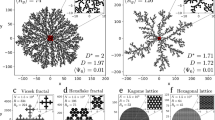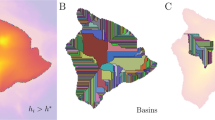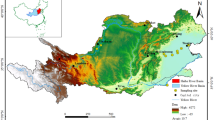Abstract
The measuring stations of most in situ geophysical networks are spatially distributed in a highly inhomogeneous manner, being mainly concentrated on continents and population centres. When inhomogeneity occurs over a wide range of scales in a space of dimension E, it can be characterized by a fractal dimension Dm. For measuring networks, there is no reason to assume a priori that Dm equals E; it will usually be less than E. The world meteorological network studied here is an example on a surface for which E = 2 (the surface of the Earth) whereas, the network has an empirical dimension Dm ≍ 1.75. Whenever Dm < E, any sufficiently sparsely distributed phenomena (with dimension Dp<E – Dm, here 0.25), cannot be detected—even if the network is infinite. Because these rare phenomena are the most intense, this insufficient dimensional resolution is associated with biases in geophysical statistics, serious difficulties in interpolating measurements to a uniform grid, and problems in calibrating remotely-sensed information.
This is a preview of subscription content, access via your institution
Access options
Subscribe to this journal
Receive 51 print issues and online access
$199.00 per year
only $3.90 per issue
Buy this article
- Purchase on Springer Link
- Instant access to full article PDF
Prices may be subject to local taxes which are calculated during checkout
Similar content being viewed by others
References
Mandelbrot, B. The Fractal Geometry of Nature. (Freeman, San Francisco).
Roux, J. C., Simoy, R. H. & Swinney, H. L. Physica 8D, 257–266 (1983).
Grassberger, P. & Procaccia, I. Phys. Rev. Lett. 50, 346–349 (1983).
Grassberger, P. & Procaccia, I. Physica 9 D, 189–208 (1983).
Nicolis, C. & Nicolis, G. Nature 311, 529–532 (1984).
Hentschel, H. G. E. & Procaccia, I. Physica, 8D, 435–444 (1983).
Grassberger, P. Phys. Lett. 97, 227–230 (1983).
Schertzer, D. & Lovejoy, S. Symp. on Turbulence and Chaotic Phenomena in Fluids, 141–144 (IUTAM, Kyoto, Japan, 1983).
Mandelbrot, B. J. Stat. Phys. 34, 895–930 (1984).
Parisi, O. & Frisch, O. Turbulence and predictability in geophysical fluid dynamics and climate dynamics (eds. Ghil, M. et al.) 84–88 (International School of Physics, Enrico Fermi, Varenna, Italy, 1985).
Shertzer, D. & Lovejoy, S. Turbulent Shear Flow, Vol. 4 (ed. Launder, B.) 7–33 (Springer, New York, 1985).
Schertzer, D. & Lovejoy, S. PCH J. (in the press).
Lovejoy, S., Schertzer, D. AMS Bull. (in the press).
Lovejoy, S. & Schertzer, D. Digital Image Processing in Remote Sensing, Ch. 14 (ed. Muller, P. J.) (Taylor and Francis, London, 1985).
Tsonis, A. A. Preprint (Univ. Wisconsin).
Author information
Authors and Affiliations
Rights and permissions
About this article
Cite this article
Lovejoy, S., Schertzer, D. & Ladoy, P. Fractal characterization of inhomogeneous geophysical measuring networks. Nature 319, 43–44 (1986). https://doi.org/10.1038/319043a0
Received:
Accepted:
Issue Date:
DOI: https://doi.org/10.1038/319043a0
This article is cited by
-
Higher-order statistics based multifractal predictability measures for anisotropic turbulence and the theoretical limits of aviation weather forecasting
Scientific Reports (2019)
-
Spatio-temporal pattern distribution of landslides causing damage in Switzerland
Landslides (2019)
-
Anisotropic Continuous-in-Scale Universal Multifractal Cascades: Simulation, Analysis and Correction Methods
Mathematical Geosciences (2018)
-
How accurately do we know the temperature of the surface of the earth?
Climate Dynamics (2017)
-
Cluster recognition in spatial-temporal sequences: the case of forest fires
GeoInformatica (2012)
Comments
By submitting a comment you agree to abide by our Terms and Community Guidelines. If you find something abusive or that does not comply with our terms or guidelines please flag it as inappropriate.



